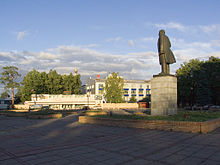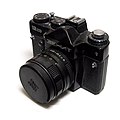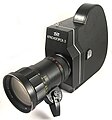Krasnogorsky Zavod
| File:Logo KMZ.svg | |
| Company type | OAO |
|---|---|
| Industry | Optical engineering, optoelectronics |
| Founded | Krasnogorsk, Russia (1942) |
| Headquarters | , |
Key people | Alexander Tarasov (director) |
| Products | Cameras, night vision devices, rangefinders, military optics |
| Parent | Shvabe (Rostec) |
| Website | http://www.zenit-foto.ru |


Krasnogorskiy zavod im. S. A. Zvereva (Russian: Красногорский завод им. С. А. Зверева, lit. 'Krasnogorsk Works named after S. A. Zverev') is a Russian factory in Krasnogorsk near Moscow which specializes in optical technology. Part of Shvabe Holding (Rostec state corporation).[1]
During the Soviet period it was called Krasnogorsk Mechanical Works (Красногорский механический завод, Krasnogorskiy Mechanicheskiy Zavod). The abbreviation KMZ (КМЗ) is still in common use.
Products
KMZ is known largely for its photographic and movie cameras of the Zorki, Zenit and Krasnogorsk series, several million of which were produced. It also has a large military optics and mechanical engineering division.
-
Zenit 12 SLR camera
-
Krasnogorsk-3 movie camera
-
Moskva 2 camera
History
Founding and post-war years
After the German invasion of the Soviet Union in World War II, the Red Army had acute need for precision optical instruments. The existing factories were either inaccessible, such as LOMO in besieged Leningrad, or overloaded with demand, such as FED which had just been evacuated from Kharkiv to Berdsk. The KMZ factory was set up in 1942 near Moscow, which by then was no longer in immediate danger from German troops, on the site of a recently evacuated mechanical plant. Initially the company took over production of scopes and binoculars as well as reconnaissance cameras.
After the end of the war, KMZ began producing photographic lenses in 1945 to the specifications of the Carl Zeiss corporation, whose factory in Jena had been overrun by the Red Army and largely carted off as war reparations. In the post-war years KMZ also began producing the Zorki camera, a close copy of the German Leica II and the Soviet FED, as well as copies of Zeiss medium-format cameras under the name Moskva. These mark the beginning of consumer production at KMZ besides the original military focus of the company. During the following years, KMZ was the main supplier of photographic lenses in the Soviet Union.
1950s and 1960s: Years of creativity
The mid-1950s saw the beginning of a period of heightened R&D activity at KMZ. One reason was that lens production could be offloaded to a number of other new optical plants, including Arsenal in Kiev which began producing lenses in 1955. This freed up valuable resources at KMZ. Another reason was the changed economic policy under Nikita Khrushchev, which placed more emphasis on producing consumer goods, such as cameras, instead of investment goods and heavy industry. As a result, KMZ produced several highly interesting concept cameras that won international prizes at fairs such as the 1958 World Exhibition in Brussels.
The company's Zorki line of rangefinder cameras underwent significant modifications that moved it gradually from being a direct Leica copy towards an original camera line of its own. Several other highly interesting rangefinder camera lines were developed out of the Zorki in the early 1960s and put to market in relatively small numbers. However, the most influential camera developed during this period was the Zenit, a single-lens reflex camera based on the Zorki rangefinder body. The Zenit line was presented in 1953, and of the first generation of Zenit cameras, more than 1.2 million units were produced until the end of the 1960s. A major redesign was presented in 1967 that made the line compatible with the M42 lens mount that was in use worldwide. In 1965, KMZ also began producing movie cameras, of which was the Krasnogorsk series for 16 mm film was the most well-known. During this time, there was substantial cooperation between the military and the civilian sections at KMZ; an example of this is the Horizont panoramic camera of 1967, which was developed out of an older artillery camera and continues to be produced in modified fashion to this day.
During this period, KMZ also produced the world's first subminiature SLR camera, the Narciss, an all-metal camera using 16mm unperforated film in special cassette, frame size 14x21mm. Narciss has a focal plane shutter, speed B,1/2,1/5,1/10,1/25,1/50,1/125,1/250 and 1/500 sec.[2]
1970s and 1980s: Catering to the domestic market
The pace of R&D for consumer products at KMZ substantially slowed down at the end of the 1960s. One reason for this might have been the relatively low output figures. Since large amounts of resources were channeled towards research and development, production figures itself were low. Under the conditions of the Soviet planned economy, these absolute production figures tended to be the main indicator for a company's productivity, which made it somewhat undesirable to invest in research and development. Another reason may have been the changed economic policy under Leonid Brezhnev, which again focused increasingly on heavy industry and arms production.
During the 1970s consumer production at KMZ shifted towards producing large numbers of individual, relatively simple models of the existing product lines. These still underwent smaller modifications and innovations, but there was a clear focus on mass production. The Zorki line of rangefinder cameras was continued until 1980 with a single model dating back to the 1956, of which 2.2 million were produced with some modifications. The Krasnogorsk-3 movie camera was produced in a largely unchanged fashion from 1971 to 1989. The Zenit line of SLRs saw somewhat more substantial modifications, such as the addition of light metering, but here too the focus was primarily on mass-producing tried-and-true models, rather than implementing technical innovations such as automatic exposure that had been standard in the West for almost a decade before they appeared on the Zenit. To cope with domestic demand, Zenit production was outsourced to several other camera works in the Soviet Union as well. More than 6 million Zenit cameras were produced at KMZ until the end of the 1980s, but by that time the Zenit comparatively outdated. During this time, the relative importance of the military section of KMZ grew, in response to the increasing focus on arms production in the USSR in general. KMZ also developed a major focus in metallurgy, mechanical engineering and optoelectronics.
In 1989, KMZ had about 32,000 employees.
Since the 1990s: Collapse and reconstruction
After the collapse of the Soviet Union, KMZ production was largely in disarray. Consumer products such as the Zenit line continued to be produced for some time, but found competition on the international market increasingly hard. KMZ continued to be present at international photography fairs such as Photokina or PMA and even presented some new products, today the company has found a niche in rifle scopes, night vision scopes, binoculars and other optical products.
Now, it is a group member of the multi-national Russian Shvabe Holding.
Logo
Before 1949 the KMZ logo was a simple dove prism, nicknamed "tomb" by factory workers. In 1949 the logo was changed to the present form, depicting a prism with a refracted ray of light.
References
- ^ "Shvabe's structure". Shvabe. Retrieved 30 April 2017.
- ^ "Г.Абрамов, "Этапы развития отечественного фотоаппаратостроения"". Photohistory.ru. Retrieved 20 October 2017.
Select bibliography
- Princelle, Jean-Loup (2004). The Authentic Guide to Russian and Soviet Cameras. Ondreville-sur-Essonne: Le Rêve. pp. esp. pp. 120–125. ISBN 2-9522521-1-4.
External links
- Official company website (in Russian)
- Actual company products (in Russian)
- Website of the company's photography and R&D division (in Russian)
- Complete list of KMZ camera products (in English)
- List of KMZ lenses (in Russian)
- Manufacturing companies of the Soviet Union
- Optics manufacturing companies
- Photography companies of Russia
- Photography in the Soviet Union
- Soviet photographic lenses
- Defence companies of the Soviet Union
- Movie camera manufacturers
- Krasnogorsky District, Moscow Oblast
- Shvabe Holding
- Companies based in Moscow Oblast






